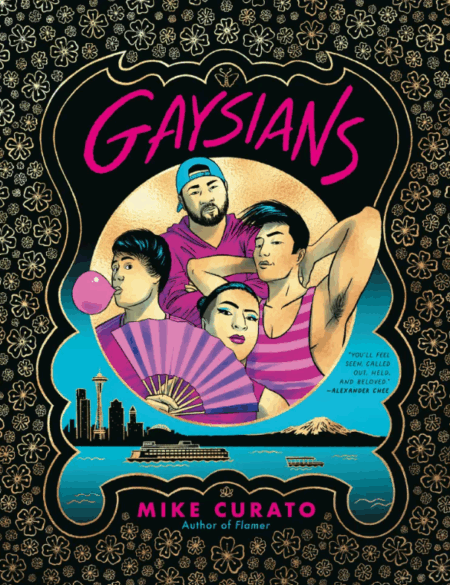I talked with Machine Dazzle, who designs the pieces of wearable art that serve as costumes — and central figures — in Taylor Mac’s A 24-Decade History of Popular Music. Machine had just arrived at his hotel for their show in Gainesville, FL, the next night, fresh off their show in Tallahassee, FL, the night before.
The show’s three-decade-spanning Act VII (1956-1986) comes to Seattle on Friday, April 20th. For more context for the below, read a preview of the show here.
Interview content is condensed and edited for clarity.
R. BARRON: What was your research approach to imagining for each decade, and what did you learn about America in doing this show?
MACHINE DAZZLE: Besides the obvious of looking at what people were wearing, I was interested in what was going on at that time. In all of the decades, dealing with the stories of the marginalized in society, breaking down the heteronormative narrative. It all comes from things that aren’t tactile — what was happening in politics, what was new, what was invented, what was important? Was there a war going on? Nothing is surface.
As far as what I’ve learned, I don’t know how to answer that really because there’s too much. But it brought a lot of issues to one place to deal with those — as in, Let’s bring all of this history in one place, and let’s just acknowledge it and deal with it in one place. Now that it’s all right here and we can deal with it and have our Radical Faerie sacrifice, let’s burn it and deal with it. And keep it in our minds that it happened. Not pretend that it didn’t happen.
R. BARRON: A lot of American history, and the music this show is themed around, is that of people who aren’t white. How does this show, and your designs, interact with that?
MACHINE DAZZLE: We don’t deal with it directly thru costume. We can’t costume Taylor in such a way to tell history that’s not ours, as white artists. There are looks I love that are central to the decades — the Black Panthers, for example — but we’re not dressing him in that. A lot of history is dealt with in music and banter from the stage, rather than costuming and appropriation.
In the full 24-Decade show, one segment is primarily songs from the underground railroad and abolitionist songs. I wasn’t going to dress Taylor as a slave, or a slave owner, and costumed him around themes of migration. With the Trail of Tears segment, we had similar concerns. I looked at using cowboy-and-Indian toys, because I wanted the reference to those. After talking with [Seattle-based artist and member of the 24-Decade production team] Timothy White Eagle, and the connection of that imagery to the annihilation of his people, for the toys I just left the cowboys to kill each other. A lot of the show is about the wrongs that have happened. There’s a lot of history on our back and it’s hard to know how to deal with it. I find a lot of people don’t even realize they’re being racists. It’s such a part of what America was built on.
R. BARRON: Does it feel different bringing this show to more conservative areas of the country?
MACHINE DAZZLE: We just came from a show in Tallahassee, and the crowd was surprisingly vibrant and really into it. You really never know. We’re on the university circuit, and this show has an intellectual bent to it. You know what the audience will be in some ways — people studying theatre and music, and whatever queer youth are around, will find out. And then the usual theatre-going, retired crowd, with all the time in the world to see theatre. And they’re either into it or not.
[And for those who aren’t?]
We’re not at the dinner table. They’re watching our show, they better sit down.
R. BARRON: Of your creations, has Taylor ever said, “No, absolutely not, I’m not wearing that”?
MACHINE DAZZLE: No. [Laughs] Taylor’s not a diva, really not that vain. Put him in something, and he just becomes the thing. Some things aren’t comfortable — heavy, for example — but he wants the challenge of wearing it.
[Note: Taylor has acknowledged the societal pressures at play in his freedom of heels in performance versus the expectation that women will wear high heels in everyday settings: “Often after shows women will say, ‘How could you wear those heels? I could never wear heels like that.’ And I always say, ‘Well for you it’s oppression but for me it’s liberation.’” Watch the NQED News interview with Taylor Mac and Machine Dazzle here.]
Some other performers are very particular, they’re not going for it. You could be so much more if you just give yourself over to it. Taylor knows he’s wearing art, and he appreciates that.
[We talked about Machine’s designs on Lily’s Revenge, the five-hour, five-act, five-director play-experience by Taylor Mac, which was one of their early collaborations. For his work on the piece, Machine put his pay back into the costumes, while juggling a full-time day job, which added to the difficulty in designing the piece. This sounded a lot like the stories of artists here in Seattle — no matter how excellent, intricate, and acclaimed or award-winning their work.]
R. BARRON: What is it about art that means it’s free — or free or underpaid to consume, with free or underpaid labor?
MACHINE DAZZLE: I think it’s because it’s not tactile. It’s not an object that’s on a shelf that they can buy and see value in, like a pair of fancy shoes, or a TV, or a car. The role models are all wrong. It’s producing a culture that puts money in other people’s pockets. But people are afraid of change.
People don’t put as much value in experiences as they should, when in fact experiences will enrich them more than any object. You can’t take objects with you. Experiences, you take with you everywhere.
Experience a three-hour, three-decade (1956-1986) version of Taylor Mac’s A 24-Decade History of Popular Music in Seattle for one night only, April 20th, at the Moore Theater. Tickets here.


















